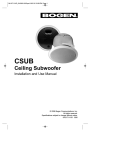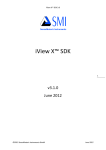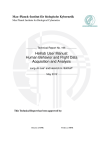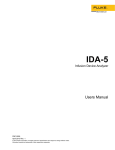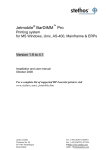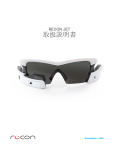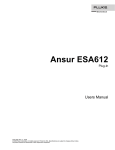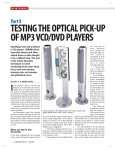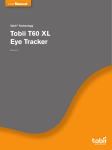Download Two gaze-detection methods for power reduction in near
Transcript
2013 IEEE 9th International Conference on Wireless and Mobile Computing, Networking and Communications (WiMob) Two Gaze-Detection Methods for Power Reduction in Near-to Eye Displays for Wearable Computing Etienne Naugle, Dr. Reynald Hoskinson Recon Instruments Vancouver, Canada [email protected], [email protected] Abstract— We present two methods for the binary detection of gaze for use in near-to-eye displays that can significantly reduce power consumption by turning off the display when the user is not actively viewing the device. A single infrared (IR) emitter-detector pair is used to detect IR reflected from the eye in order to estimate gaze and can reduce the power consumed by the display by over 75%. The first method presented is more configurable and adaptive but requires continuous polling of an analog sensor. The second method is interrupt driven and, except for calibration, the sensor IC is not polled by the host processor. Current gaze tracking systems utilize multiple IR light sources, a digital camera, and image processing to determine the direction of gaze. Typically each user must calibrate the system for each usage period by glancing at indicated locations during calibration. This type of gaze tracking requires expensive equipment, and is intensive in terms power, computation, and user attention. For a mobile device with limited battery power the solution would be worse than the problem. What is required is not necessarily gaze tracking, but gaze detection. Keywords— Head-mounted display (HMD); Near-to-eye display; human computer interaction; mobile computing; pervasive computing; power saving methods We have developed a novel, simple, low cost, low power, and minimally computationally intensive solution that accurately detects when the users glances at the display so that it is only active when it is observed. The benefit of this system is that it conserves power by turning off the display when the user’s attention is elsewhere and provides instantaneous (as far as the user is concerned) reactivation of the display by simply glancing at the display. Additionally, our solution is self calibrating for most users without the need for manual calibration. In the first implementation the host processor is continuously active. It controls an IRLED, reads the reflected IR from a sensor via an ADC (analog to digital converter), then enables/disables the display based on the changes in IR signal. This arrangement requires continuous pulse width modulation (PWM) control of the IRLED and polling of the sensor but allows more flexibility of the detection algorithm. In the second implementation an integrated sensor IC is used so that the host processor can be put to sleep when not in use and woken via interrupt to change the display state. The host processor only reads the ADC values during calibration, thereafter the enabling and disabling of the display is performed via an interrupt. This technique can promote additional power savings but is not as adaptable as the continuous polling method. Each of these methods can reduce the power consumed by the NED by over 75%. I. INTRODUCTION Within the field of mobile computing there have been many attempts to create a wearable computer system with an integrated near-to-eye display (NED) that allows the user to have persistent and instantaneous access to information. One problem with these systems is that for the display to be continuously available to the user, it must be active and drawing power at all times. Smartphone-like devices can power down their screens when not in use and require a button press to activate in order to conserve power, but for an NED this would negatively affect the user experience, as it is normally hands-free. Having the display continuously powered when the user may be looking at it less than ten percent of the time wastes battery resources that are critically short in these types of mobile devices. Recently there have been several NEDs introduced that are monocular and relatively low-field of view. The display is placed outside of the user's normal gaze, so that he or she must consciously look at it (typically down or up) to see the screen. In this way the display is easy to ignore when the user is not actively engaged with it. The use cases of such an NED are typically information that can be glanced at and absorbed within a minute or two. The position of the display and the interaction use cases also minimize any discomfort the user would normally experience when looking at a monocular display over a long period of time. As a result, there is a substantial amount of time that the display is idle. Since power consumption is a key parameter that affects both device lifetime and overall form-factor, we could take advantage of this user behavior to turn off the display when the user is not actively engaged with the NED. 978-1-4799-0428-0/13/$31.00 ©2013 IEEE The rest of the paper is organized as follows: Section II reviews eye tracking theory and previous work is presented; Section III describes the two methods of binary gaze detection; Section IV presents the test methods and results; Section V demonstrates the power savings available for each method; Section VI concludes the paper and presents future avenues of research and development. II. PRIOR EYE-TRACKING METHODS Eye-tracking has historically been used for researchers to determine how we use our eyes for different tasks, what we 675 focus on during diverse activities, and more recently to give people with extreme motor difficulties the ability to communicate[1]. Typical eye tracking implementations rely on the use of a camera capable of detecting IR light and one or more IR light sources. The two general methods of eye tracking using IR light are the bright pupil and dark pupil effects, sometimes combined for more robust detection [2]. The bright pupil effect occurs when an IR light source is placed near the camera and the light reflected off the retina is measured. When the IR source is placed off axis from the camera, the IR light illuminates the eye but is not retroreflected, so the pupil appears as a black circle called the dark pupil effect [3]. Some methods also include corneal glint to map the relative position of the pupil to the sphere of the eye [4]. While these methods are fairly robust, it must be noted that not all eyes will reflect the same amount of IR light, and the use of corrective contact lenses may affect the amount of light reflected as well[5]. sleep instead of monitoring a sensor continuously. For both methods, test subjects expressed surprise at the rapid response time of the system, the display appearing to be on as they glanced at it, with no discernible delay. A. Discrete Component Implementation The emitter-detector pair chosen for the discrete component implementation are the QEC122/QSC112 matched diodes from Fairchild Semiconductor, mounted on top of the display and as close to coaxially with the optical axis of the display optics as possible. By mounting the sensor above the display and aligned with the optical axis, when the user adjusts the display so that it is comfortably visible, the sensor is also adjusted to properly detect gaze. The QEC122/QSC112 pair was chosen firstly because the peak emission wavelength of 850nm is preferable to the other standard IR LED wavelength of 950 nm, which is more readily absorbed by the human eye[14][15]. Secondly, the emission half angle for the QEC122 is 9° while other similar components have emission half angles of 18 to 25 degrees; a smaller emission angle focuses more of the IR on the eye and less on the surrounding skin. Commercial eye-tracking devices available in the market are typically laboratory desktop tools designed for research purposes and are not suited to embedding in a small field of view (FOV) NED [6][7][8][9]. Several mobile eye tracking devices are available, including the Tobii Glasses [10] and the SMI Eye Tracking Glasses [11], however these remain fairly bulky and are not meant for integration into other devices. Alternatively, lower-cost eye tracking can be accomplished using a USB webcam, IR LEDs, and a computer running image processing software that maps the images to gaze direction [1][12][13]. All of these devices require a calibration stage, typically in which the user is asked to focus on a point, or a series of points so that the image processing software can correctly determine gaze during use. The power-consumption required to operate the camera and image processing software to determine gaze angle can diminish or even reverse the power saved from turning off the display. III. In the initial testing it was determined that a voltage difference could be detected (tested with a digital multi-meter) when voltage supplied was constant. To further reduce power, a microcontroller-based experimental platform was created to implement pulse-width modulation (PWM) of the IR emitter. An STM32F4 microcontroller was used to manage output to the IR LED via a PWM signal. The microcontroller also read voltage values via a built-in ADC, and displayed a target image in the NED. The display was on a short boom attached to a pair of sunglasses with the lenses removed, as illustrated in Fig. 1. The display was positioned below the user’s normal straightahead gaze and had some adjustability to allow the user to position the display in order to properly see the image. As previously noted, the IR emitter-phototransistor pair were aligned with the optical axis so that when the display was properly adjusted, the gaze detector was also properly aligned. BINARY GAZE DETECTION For a low FOV (<20°) NED there is little need for comprehensive tracking of eye movements, as commercial eyetrackers typically have an accuracy on the order of plus or minus 1° so the utility of tracking the eye within that FOV is limited. There remains the potential for power savings by being able to detect when a user is looking at the display. We have developed a low cost (in terms of both monetary costs and computational power required) technique for determining when a user is engaged with the display. The display is only powered when the user looks at it and is disabled the rest of the time. In order to create a binary detector that would be able to simply determine whether or not the user was looking at the display, we reduced the complex IR lights, CCD camera, and image processing software system to a single IR emitter and detector. In the following sections we describe two approaches to detecting eye gaze in this manner. The discrete component implementation is best used in applications in which an additional dedicated low power microcontroller available, as it requires control of an IRLED and continuous polling of an analog sensor with an ADC. The interrupt driven implementation is preferable for applications with a higherpower host processor where it would be beneficial to allow it to Finally, the microcontroller actively controlled the display state based on the readings from the ADC and a control algorithm. There is a significant variation in the amount of IR signal reflected by different users and so calibration is needed for each user in order to set thresholds for display control. An Fig. 1. QEC122/QSC112 mounted on display for discrete component method testing 676 algorithm was developed to eliminate the need for individual users to perform a calibration routine to successfully use the gaze detection. Instead of setting thresholds for DISPLAY_ON and DISPLAY_OFF states, a percentage change algorithm was employed. A comparison of the percent change for each subject between natural eye motion and restricted eyelid motion from the initial experiment is presented in Fig. 2. This data was used to select the percent change thresholds. Based on previous trials, a percent change difference defined DISPLAY_ON and DISPLAY_OFF states was used, as shown in Fig. 3. In this way, calibration is achieved automatically based on change from the current signal instead of absolute thresholds. Initial testing continued with a 10Hz signal at 10% PWM for the IR emitter control. Using these parameters the system worked but was felt to be a bit sluggish and so the frequency was increased to 20Hz, keeping a 10% PWM control signal. B. Integrated CircuitUsing Interupts Implementation In an attempt to further reduce power, microcontroller computations and the size of the sensor, an off-the-shelf integrated circuit solution was pursued. A small form factor (3.94 mm x 2.36mm x 1.35 mm) IC that contains an IRLED, IR sensitive photodiode, and an ADC was selected to perform the detection. A static position for the sensor was desired in order to reduce the mechanical complexity and size of the adjustable display portion. To simulate an NED, a boom that could be attached to sunglasses was 3D printed (similar to the boom used for the discrete component implementation). The location of the sensor position was determined using the ANSUR [16] database (using data on head breadth and interpupilary distance) such that the emission angle (25°) of the IRLED would illuminate a significant portion of the eye on the majority of subjects. The wider emission angle of the sensor was leveraged in this implementation to allow for a static position. The sensor was controlled by an STM32F4 microcontroller that performed the initial setup and calibration of the sensor as well as the control of an LED representing the Fig. 3. Flow chart of control logic for descrete component implementation demonstrating the lack of need for a calibration due to operating on changes not thresholds display state to the subject. As discussed previously, the IR reflectivity of the face varies from person to person and so the device must be calibrated for each subject. In contrast to the discrete component method, the IC method does not continuously poll the sensor; one approach to calibrating the sensor is by training the sensor and host processor to the subject. Training the system would require the subject to glance at the display and away from the display, much like traditional IR-based eye tracking. However, it would be a better user experience if training were not required. In order to create a near seamless experience for the user we have designed an automatic calibration that runs at startup. The initial prototype of the calibration algorithm was created with five subjects. See Fig. 4 for details of the automatic calibration algorithm, once calibrated thresholds are set on the IC and an interrupt based approach is used. This calibration routine does not require the user maintain any particular gaze direction, they are able to glance around naturally. A similar upkeep calibration is run periodically to keep sensor readings stable. The current implementation requires three successive readings exceeding the threshold for a DISPLAY_ON state change and twelve successive readings exceeding the threshold for a DISPLAY_OFF state change. The IC is configurable to generate interrupts after waiting for these conditions. This is so that the display activation time is not noticeable to the user and remains on even with minor eye movements. The change to the DISPLAY_OFF state can be slower, or even faded out. IV. SUBJECT TESTING AND RESULTS A. Discrete Component In order to determine the usability of the gaze detection system using discrete components, trials were performed with ten individuals to measure the voltage differences between looking at the display and looking straight ahead. The subjects Fig. 2. Average Percent Change for both Natural Eye and Restricted Eyelid Movements. Subjects designated by initials. 677 system. They were then asked to position the sunglasses comfortably on their face and the automatic calibration was initiated. The subjects were instructed that they could move their heads and direct their gaze as they wished and that the display LED would flash several times once the display was calibrated. At this point subjects were told to explore the ability of the system to detect their gaze for as long as they wished. A 'false positive' is defined as the device turning on the LED when the user is not looking at the display and a 'false negative' occurs when the display is turned off when the user is looking at it. False positives are of little concern because they would default to the behavior of the NED without gaze detection, with the addition of a small extra power drain of the gaze detection system. False negatives, on the other hand, are very serious as they would appear to the user that the device has failed. Typically subjects used the system for between 5 and 10 minutes. Of the 48 subjects tested 27 reported that the detection worked well for them, 11 reported occasional false positives, and 10 reported that the detection was somewhat intermittent. None of the subjects reported the gaze detection failing completely. Fig. 4. Flow Chart of automatic calibration of the IC implementation that accounts for differences in IR reflectivity. were instructed to position the display below their normal gaze and to adjust it so they could comfortably see the image. Each subject was asked to focus on the wall in front of them in a comfortable, normal, straight-ahead gaze and then down at the image on the display. All subjects had an increase in phototransistor voltage when they changed gaze from looking straight ahead to looking directly at the display. For most of these subjects the increase was fairly large, with the average being 118mV, using a 1.8V driving voltage. Initially we thought a simple threshold algorithm could be used to determine whether the subject was looking at the display, with a DISPLAY_ON state occurring if the voltage was above a set value and a DISPLAY_OFF state occurring if the voltage was below a different set value, with a small buffer zone between. However, initial results showed a significant variation in IR reflectivity. In the second experiment data was collected for each subject in order to improve the automatic calibration, upkeep calibration, and detection thresholds based on increasing values for the number of IRLED pulses per cycle. Each subject was instructed to put the glasses on comfortably and to choose a spot on the wall to be their normal, straight-ahead gaze. The display LED was kept lit for the duration of this experiment and the subjects looked alternately at the display and straight ahead, based on the prompting of the experimenter. For each gaze position five sequential readings of the ADC were stored and then the number of IRLED pulses per cycle was increased. This continued until the ADC was saturated (1024) for both the straight ahead and at the display gaze. Fig. 5 illustrates the difference in IR reflectivity between a subject with excellent gaze detection and a subject with intermittent gaze detection. As can be seen, the intermittent case has significantly less differentiation between their straight ahead gaze and when they glance at the display, with only three IR Pulse count values having a difference greater than 150. The subject with excellent gaze detection (Subject 1) has six IR pulse count settings in which the difference is over 300. This variation between subjects must be accounted for both in calibration and during detection of gaze. The data collected from this experiment is being used to further refine the algorithm to provide more robust detection in all subjects. Further subject testing was performed using the microcontroller running the gaze detection algorithm using percent change, which controlled an external LED to indicate to the experimenter the state of the display. Twenty subjects (including six from the previous trial) were instructed to wear the experimental setup and adjust the display so that it could be seen properly. They were then asked to look straight ahead and down at the display alternately as directed by the experimenter. The ADC values and the LED representing the display state were monitored and recorded. Of these 20 subjects, only one did not change the display state, and two were intermittently responsive. The final experiment was performed to map which portions of the eye and face the IRLED was illuminating in order to cross correlate the readings of the detector. A Logitech C210 USB webcam was modified by removing the IR filter and replacing it with a visible light filter to create a camera sensitive to IR light and not affected by ambient visible light. The IRLED was set to the shortest wait time, a pulse current of 50mA, and 150 pulses per cycle. This was necessary in order for the camera to be able to record an appropriate image. Changing the number of pulses per cycle or the wait time did not change the area illuminated, only its intensity, and these values were found to produce a good representation of the illumination. Fig. 6 reveals the difference in IR illumination of B. Integrated Sensor Validation testing of the calibration and detection algorithms were performed using 48 subjects, including the five original subjects. Three experiments were performed with each subject in order to test the algorithms and gather data for future refinement. In the first experiment the subjects were introduced to the prototype, shown the LED indicating display state and location and given basic information regarding the operation of the 678 sensor; it is able to reject the changes in ambient IR. V. POWER SAVINGS For an NED where the primary use case is as a glance-able display, the power savings of having the display inactive when the user’s attention is busy elsewhere can be significant. The backlight alone in some micro-LCD displays can use approximately 100mW at full brightness and 60mW at half brightness. In order to compare our solution to current eye tracking methods we relied on figures published in user manuals and experimentally obtained data. The Tobii glasses are designed primarily for market research applications and contain three primary sensors: eye-tracking camera, forward facing scene camera, and forward facing IR sensor for establishing connection with IR tags. The eye-tracking is done on an attached Recording Assistant. According to the Tobii Glasses user manual, the system has a 2260mAh, 3.7V battery and can be used for up to 70 minutes, sampling at a rate of 30Hz [17]. The total system consumption is 7.2 W; if we assume that each primary sensor consumes 1/3 of the power including the processing, then the eye-tracking portion consumes 2.4 W. The modified Logitech C210 camera used to take IR images is similar to those suggested by openEyes [13] and was measured to consume 0.5W even without image processing. Fig. 5. A comparison of the IR reflectivity data for increasing number of IRLED pulses per cycle for two subjects. Subject 1 had excellent detection and corresponds to the upper set of images in Fig. 6. Subject 2 had intermittent detection and corresponds to the lower set of images in Fig.6. the eye between a representative subject with excellent detection results and a representative subject with intermittent detection. As can be seen, the stationary position of the sensor does not illuminate all subjects equally and this contributes to the differences in detection capabilities. Subject 1 primarily has their eye illuminated, while subject 2 primarily has the upper cheek illuminated with only a small portion of the eye. While there is a much smaller detectable difference in reflected IR for subject 2, detection is still possible with proper calibration and thresholding. The IR reflection data for these subjects has been shown in Fig. 5. Computation of the power consumption of our system includes the power of the display, an estimation of use time, and the power consumption of the sensor. As the gaze detection system runs regardless of whether the display is on or not, the power (Watts) is additive, and can be estimated by (1) C. Sunlight and Ambulatory Testing Initial testing has been performed using subjects who are moving, both indoors and out. For the discrete component method the ambient IR rejection is not implemented and therefore in strong sunlight the sensor is saturated. Tests of the IC method have shown the similar results to the seated subject testing where there are some false positives but not false negatives. Overall the performance is very robust. Moving from sunlight to shadow or vice versa has no effect on the Ptotal = Pdisplay *tON + PGaze Detection where Pdisplay is the power used by the display when it is on, PGaze Detection is the continuous power used by the gaze detection hardware, and tON is the percentage of time that the user will be looking at the display during use. On the discrete component setup, assuming a 20% user interaction, the gaze detection hardware utilizes only 2.4mW on average (the power usage is partially dependent on the user, those who reflect more IR and have a higher baseline will cause the gaze detector to consume slightly more power, ±.03mW). In this implementation it follows that the user only needs to interact with the display less than 97% of the time at full brightness, or 96% of the time at half brightness for this solution to be viable. Assuming a display at half brightness and a user interaction of 20%, the power consumption of just the display backlight is reduced from 60mW to 14.4 mW. Using the integrated circuit setup the consumption of the sensor of a typical user is even further reduced to 0.78mW for the average user and 1.26mW for the maximum number of IRLED pulses per cycle. This method also reduces the overall power consumption of the system as the host processor no longer needs to be awake to perform any ADC readings or calculations and is only woken up by the interrupt on state change. Power savings of this kind will highly depend on the type of MCU or CPU being used as the host processor. As has Fig. 6. A visual comparison of IRLED illumination for a subject with excellent detection (top) and a subject with intermittent detection (bottom) 679 been shown, our solutions consume less power than other gaze tracking systems by several orders of magnitude. reflection values. The current IC implementation relies on a stationary sensor with a wide emission angle (25°) for the IRLED. The accuracy and reliability of the sensor could be improved by attaching the sensor directly to the NED, close to the optical axis, and limiting the emission angle of the IRLED. Depending on the application the NED is being used for, it may be possible to further reduce power consumption when the user is not looking at the display. If the system is fast enough, the entire display chain could be put into standby. Additionally, if there are portions of the system that never need to be active unless the user is actively using the unit, these could also be shut down, as long as tests determine that they are able to be initialized again quickly enough that it does not negatively impact user experience. REFERENCES [1] [2] [3] VI. CONCLUSION AND FUTURE WORK [4] We have shown that the use of a simple device consisting of a single IR emitter/IR detector pair, either discrete or integrated, has the potential to greatly reduce the power consumption of mobile devices that utilize near-to-eye displays without negatively impacting the user experience. With these methods of gaze detection the display will remain off until the user chooses to interact with it, but will be instantly on when they glance at the display. The power consumption of the display can be reduced by over 75% using either method. [5] [6] [7] [8] Given the data collected, both methods presented are viable in detecting gaze and reducing power consumption. The first method with discrete components may be most suited to applications in which there is a low power microcontroller which can be used to continuously poll the IR sensor without involving the main CPU. In applications in which a larger CPU is being used as the primary processor as well as sensor controller the IC method may be best. This would allow much of the system to be put to sleep when the user is not glancing at the display further increasing power savings. [9] [10] [11] [12] There are several challenges and improvements that can be made to increase the viability and usability of this system. Using the data collected from the subjects regarding the reflectance of IR at different eye positions, a more robust calibration algorithm is being created, including tuning of the thresholds. Optional additional sensitivity modes for users who fall outside this default could also be examined, or in extreme cases, allow the user to train the device. Further work with a complete working NED device is planned in order to determine necessary response time for seamless interaction for the user as well as exploring how much of the display chain can be disabled for even greater power savings. Ambient IR rejection must be improved for the present discrete component prototype so that it can be used in sunlight. This may require additional algorithms using improved statistical analysis such as FFT or comparing to the standard deviation of a subset of previous IR [13] [14] [15] [16] [17] 680 ‘EyeWriter’. [Online]. Available: http://www.eyewriter.org/. [Accessed: 10-Feb-2012]. C. H. Morimoto, D. Koons, A. Amir, and M. Flickner, ‘Pupil detection and tracking using multiple light sources’, Image Vis. Comput., vol. 18, no. 4, pp. 331–335, 2000. L. R. Young and D. Sheena, ‘Survey of eye movement recording methods’, Behav. Res. Methods, vol. 7, no. 5, pp. 397–429, 1975. T. E. Hutchinson, K. P. White Jr, W. N. Martin, K. C. Reichert, and L. A. Frey, ‘Human-computer interaction using eye-gaze input’, Syst. Man Cybern. IEEE Trans., vol. 19, no. 6, pp. 1527–1534, 1989. K. Nguyen, C. Wagner, D. Koons, and M. Flickner, ‘Differences in the infrared bright pupil response of human eyes’, in Proceedings of the 2002 symposium on Eye tracking research & applications, 2002, pp. 133–138. ‘Eyetracking and Eye Tracker | Sensomotoric Instruments (SMI)’. [Online]. Available: http://www.smivision.com/. [Accessed: 10-Feb2012]. ‘Seeing Machines’. [Online]. Available: http://www.seeingmachines.com/. [Accessed: 10-Feb-2012]. ‘smarteye | If you want reality’. [Online]. Available: http://www.smarteye.se/. [Accessed: 10-Feb-2012]. B. R. Nickerson, Eye tracking for resource and power management. Google Patents, 2003. ‘Tobii Glasses Eye Tracker Mobile Shopper research’. [Online]. Available: http://www.tobii.com/en/eye-trackingresearch/global/products/hardware/tobii-glasses-eye-tracker/. [Accessed: 17-Jul-2012]. ‘SMI Eye Tracking Glasses, mobile eye tracking glasses by SensoMotoric Instruments (SMI)’. [Online]. Available: http://eyetracking-glasses.com/. [Accessed: 17-Jul-2012]. J. S. Babcock and J. B. Pelz, ‘Building a lightweight eyetracking headgear’, in Proceedings of the 2004 symposium on Eye tracking research & applications, 2004, pp. 109–114. D. Li, J. Babcock, and D. J. Parkhurst, ‘openEyes: a low-cost headmounted eye-tracking solution’, in Proceedings of the 2006 symposium on Eye tracking research & applications, 2006, pp. 95–100. A. E. Elsner, S. A. Burns, J. J. Weiter, and F. C. Delori, ‘Infrared imaging of sub-retinal structures in the human ocular fundus’, Vision Res., vol. 36, no. 1, pp. 191–205, 1996. T. J. T. . van den Berg and H. Spekreijse, ‘Near infrared light absorption in the human eye media’, Vision Res., vol. 37, no. 2, pp. 249–253, 1997. C. C. Gordon, T. Churchill, C. E. Clauser, B. Bradtmiller, and J. T. McConville, ‘Anthropometric survey of US army personnel: methods and summary statistics 1988’, DTIC Document, 1989. ‘Tobii Glasses User Manual.pdf’. [Online]. Available: http://www.tobii.com/Global/Analysis/Downloads/User_Manuals_and_ Guides/Tobii%20Glasses%20User%20Manual.pdf. [Accessed: 09May-2013].






